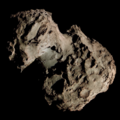260P/McNaught
 Comet McNaught 4 photographed from the Zwicky Transient Facility on 3 October 2019 | |
| Discovery[1][2] | |
|---|---|
| Discovered by | Robert H. McNaught |
| Discovery site | Siding Spring Observatory |
| Discovery date | 20 May 2005 |
| Designations | |
| P/2005 K3, P/2012 K2 | |
| McNaught 4 | |
| Orbital characteristics[4][5] | |
| Epoch | 9 August 2022 (JD 2459800.5) |
| Observation arc | 14.81 years |
| Number of observations | 6,792 |
| Aphelion | 5.831 AU |
| Perihelion | 1.415 AU |
| Semi-major axis | 3.623 AU |
| Eccentricity | 0.60935 |
| Orbital period | 6.897 years |
| Inclination | 15.058° |
| 349.34° | |
| Argument of periapsis | 18.432° |
| Mean anomaly | 151.97° |
| Last perihelion | 10 September 2019 |
| Next perihelion | 5 August 2026[3] |
| TJupiter | 2.717 |
| Earth MOID | 0.495 AU |
| Jupiter MOID | 0.024 AU |
| Physical characteristics[6][7] | |
Mean radius | 1.54±0.09 km |
| 8.16±0.24 hours | |
| Comet total magnitude (M1) | 12.7 |
| Comet nuclear magnitude (M2) | 15.4 |
Comet McNaught 4, also known as 260P/McNaught, is a periodic comet with a 6.9-year orbit around the Sun. It is one of several comets discovered by Australian astronomer, Robert H. McNaught.
Observational history
[edit]On 20 May 2005, Robert H. McNaught found his fourth periodic comet (P/2005 K3) from the 0.5 m (1.6 ft) telescope of the Siding Spring Observatory,[1] where he reported it has a slightly diffuse head with a narrow tail about 30 arcseconds in length.[2]
It was later rediscovered in 15–18 May 2012 from the Pierre Auger Observatory as P/2012 K2,[8] which was later confirmed to be a recovery of comet McNaught 4 a few days later.[9]
During its 2019 apparition, a small outburst had temporarily brightened the comet from magnitude 13.78 to 13.59.[10]
Physical characteristics
[edit]Photometric analysis of the comet between August 2012 and January 2013 has determined that its nucleus rotates at a single axis, completing one stable rotation once every 0.34 ± 0.01 days (8.16 ± 0.240 hours).[6]
The nucleus itself has an effective radius of 1.54 ± 0.09 km (0.957 ± 0.056 mi).[7] However, near-infrared observations from the Spitzer Space Telescope found a smaller effective radius at around 0.322±0.04 km, indicating that it may have an elongated shape.[11]
References
[edit]- ^ a b R. H. McNaught (1 June 2005). B. G. Marsden (ed.). "Comet P/2005 K3 (McNaught)". Central Bureau Electronic Telegrams (161). Bibcode:2005CBET..161....1M.
- ^ a b R. H. McNaught (7 June 2005). D. W. Green (ed.). "Comet P/2005 K3 (McNaught)". IAU Circular (1). Bibcode:2005IAUC.8535....1M.
- ^ S. Yoshida (30 June 2021). "260P/McNaught". www.aerith.net. Retrieved 1 June 2025.
- ^ "260P/McNaught – JPL Sma§ll-Body Database Lookup". ssd.jpl.nasa.gov. Jet Propulsion Laboratory. Retrieved 1 June 2025.
- ^ "260P/McNaught Orbit". Minor Planet Center. Retrieved 1 June 2025.
- ^ a b F. Manzini; V. Oldani; R. Crippa; J. Borrero; et al. (2014). "Comet McNaught (260P/2012 K2): spin axis orientation and rotation period". Astrophysics and Space Science. 351 (2): 435–450. arXiv:1403.5703. Bibcode:2014Ap&SS.351..435M. doi:10.1007/s10509-014-1854-6.
- ^ a b M. M. Knight; R. Kokotanekova; N. H. Samarasinha (2023). "Physical and Surface Properties of Comet Nuclei from Remote Observations". arXiv:2304.09309 [astro-ph.EP].
- ^ M. Masek; G. V. Williams (21 May 2012). "MPEC 2012-K37: Comet P/2005 K3 = 2012 K2 (McNaught)". www.minorplanetcenter.net. Minor Planet Center. Bibcode:2012MPEC....K...37M. ISSN 1523-6714. Retrieved 2 June 2025.
- ^ M. Masek; G. V. Williams; S. Nakano (May 2012). D. W. Green (ed.). "Comet P/2012 K2 = P/2005 K3 (McNaught)". Central Bureau Electronic Telegrams (3113). Bibcode:2012CBET.3113....1M.
- ^ M. S. P. Kelley; D. Bodewits; Q. Ye (8 October 2019). "Small outburst of comet 260P/McNaught". The Astronomer's Telegram. 13174. Bibcode:2019ATel13174....1K.
- ^ M. L. Paradowski (2020). "A new method of determining brightness and size of cometary nuclei". Monthly Notices of the Royal Astronomical Society. 492 (3): 4175–4188. Bibcode:2020MNRAS.492.4175P. doi:10.1093/mnras/stz3597.
External links
[edit]- 260P/McNaught at the JPL Small-Body Database
- 260P/McNaught at Gideon van Buitenen's website


